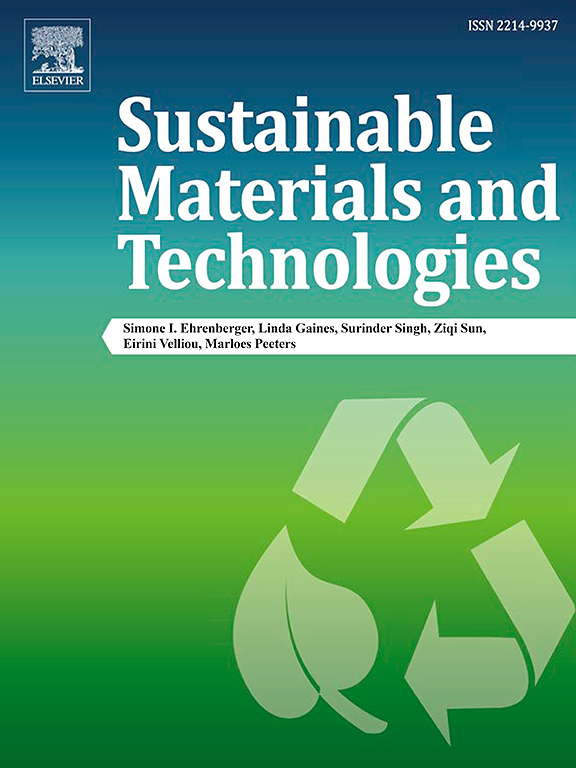通过综合生命周期评估回收耐氢 La0.6Ca0.4Co0.2Fe0.8O3-d 氧传输膜,用于等离子体辅助二氧化碳转化
IF 8.6
2区 工程技术
Q1 ENERGY & FUELS
引用次数: 0
摘要
在这项研究中,对耐氢性 La0.6Ca0.4Co0.2Fe0.8O3-d (LCCF_6428) 氧传输膜采用了回收方法,这种膜在等离子体辅助二氧化碳转换技术中具有巨大潜力,可用于生产甲醇等工业燃料。主要重点是纳入可持续发展措施,如在早期阶段将生命周期评估(LCA)纳入材料开发,以研究和比较再生膜与原生膜在环境方面的可行性。其目的还在于通过回收利用,确保减少钴和镧等关键原材料的资源损耗。它包括微波辅助溶解膜,然后进行超声波喷雾合成。回收膜的透氧率至少是原膜的 83%,并在 600 °C 的温度下保持 25 小时的耐氢性,这对 LCCF_6428 来说是一个显著的结果,有可能延长其使用寿命。根据生命周期评估,回收利用确实降低了资源损耗。不过,与原生 LCCF 相比,回收的 LCCF 对环境的总体影响更大,这主要是由于在回收过程中增加了耗电量。这些结果表明,有必要向更高效的工艺过渡,同时使用更清洁的可再生能源,这也是将生命周期评估纳入材料开发以确定材料可持续性概况的关键所在。本文章由计算机程序翻译,如有差异,请以英文原文为准。
Recycling of hydrogen tolerant La0.6Ca0.4Co0.2Fe0.8O3–d oxygen transport membranes with integrated life cycle assessment for plasma-assisted CO2-conversion
In this study, a recycling approach was adapted for the hydrogen tolerant La0.6Ca0.4Co0.2Fe0.8O3–d (LCCF_6428) oxygen transport membranes that have great potential in plasma-assisted CO2 conversion techniques for producing industrial fuels such as methanol. The major focus was the incorporation of sustainability measures such as integrating life cycle assessment (LCA) into the materials development at an early stage to study and compare the environmental feasibility of the recycled membrane with the primary membrane. The aim was also to ensure reduced resource depletion of critical raw materials such as cobalt and lanthanum by means of recycling. It consisted of microwave-assisted dissolution of the membrane followed by ultrasonic spray synthesis. The recycled membrane exhibited at least 83 % of the oxygen permeability of the primary membrane and maintained hydrogen tolerance up to 600 °C for 25 h which is a remarkable result for LCCF_6428 in terms of potentially enhancing its life span. As per the LCA, recycling did result in lower resource depletion. However, the recycled LCCF had a higher overall environmental impact compared to the primary LCCF, mainly due to increased electricity consumption during recycling. These results accentuate the need for a transition towards more efficient processes accompanied by cleaner and renewable sources of energy and critically indicate integration of LCA into materials development to establish the sustainability profile of materials.
求助全文
通过发布文献求助,成功后即可免费获取论文全文。
去求助
来源期刊

Sustainable Materials and Technologies
Energy-Renewable Energy, Sustainability and the Environment
CiteScore
13.40
自引率
4.20%
发文量
158
审稿时长
45 days
期刊介绍:
Sustainable Materials and Technologies (SM&T), an international, cross-disciplinary, fully open access journal published by Elsevier, focuses on original full-length research articles and reviews. It covers applied or fundamental science of nano-, micro-, meso-, and macro-scale aspects of materials and technologies for sustainable development. SM&T gives special attention to contributions that bridge the knowledge gap between materials and system designs.
 求助内容:
求助内容: 应助结果提醒方式:
应助结果提醒方式:


